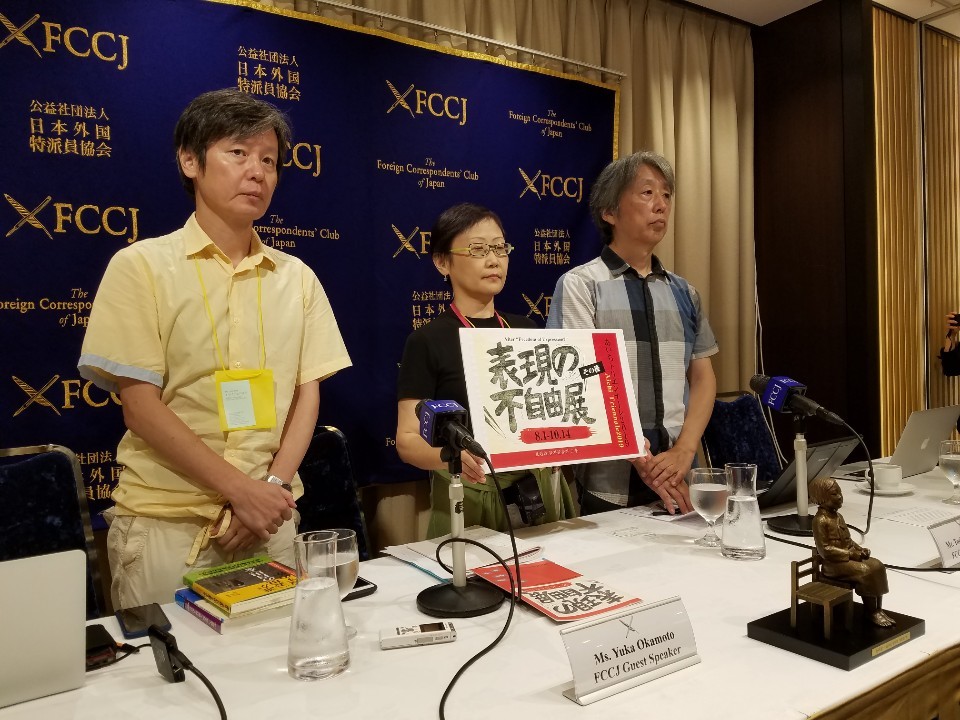 |
|
Curators hold a press conference at the Foreign Correspondents’ Club of Japan (FCCJ) in Tokyo on Sept. 2 to demand the reopening of the exhibition “After ‘Freedom of Expression?’” after it was shut down just three days after its opening.
|
Press conference at Foreign Correspondents’ Club of Japan points to censorship
“They [the organizers of the Aichi Triennale] claim that the suspension of the ‘After Freedom of Expression?’ exhibition was intended for security reasons rather than as censorship, but I don’t believe that. Not showing works of art constitutes censorship.” Curators held a press conference at the Foreign Correspondents’ Club of Japan (FCCJ) in Tokyo’s Chiyoda Ward on Sept. 2 to demand the reopening of the suspended “After Freedom of Expression?” exhibition, which included a statue of a girl symbolizing women drafted into sexual slavery, euphemistically referred to as “comfort women,” under the imperial Japanese military. On Aug. 3, Aichi Gov. Hideaki Omura announced the suspension of the entire “After Freedom of Expression?” exhibition just three days after its opening, citing threatening phone calls and faxes warning of terrorist acts. “Gov. Omura and Daisuke Tsuda, the Aichi Triennale’s artistic director, should have listened to what we the curators had to say about the exhibition’s suspension and kept in line with that,” argued Yuka Okamoto, one of the exhibition’s curators, in remarks that day criticizing the unilateral suspension decision by the Aichi Triennale’s organizers. “They prevented staffers from hanging up on protest calls [by right-wingers] on the grounds that they were ‘government employees,’” Okamoto noted. “There also needed to be advance training for staffers, and there wasn’t any,” she added. Hiroyuki Arai, an art critic and fellow curator, said, “Most of the censorship in Japan concerns works of art that deal with dark aspects of Japan’s history.” “It’s a trend that has grown since 2015, and it’s intensified a lot recently in particular,” he said. “Did Aichi Prefecture really do all it could to uphold freedom of the press? We’re skeptical,” he added. A third curator, Toshimaru Ogura, said, “Aichi Prefecture has a major city in Nagoya and has hosted numerous international conferences – and yet they can’t protect a small exhibition like this one?” “I suspect they just didn’t really want [the exhibition] taking place,” he suggested. The works in the “After Freedom of Expression?” exhibition, including the comfort woman statue, remain at the venue – but a partition has been erected in front of it to prevent viewers from seeing them. The curators have called for reopening the exhibition before the Aichi Triennale event’s closing date of Oct. 14. Omura has dragged his feet on the exhibition’s reopening, calling instead to wait and see the results of an inspection committee’s examination of the “After Freedom of Expression?” exhibition. During a press conference earlier that day in the same venue as the curators, Tsuda said it was too early to give a clear answer on the reopening question at the present time. By Cho Ki-weon, Tokyo correspondent Please direct comments or questions to [english@hani.co.kr]






